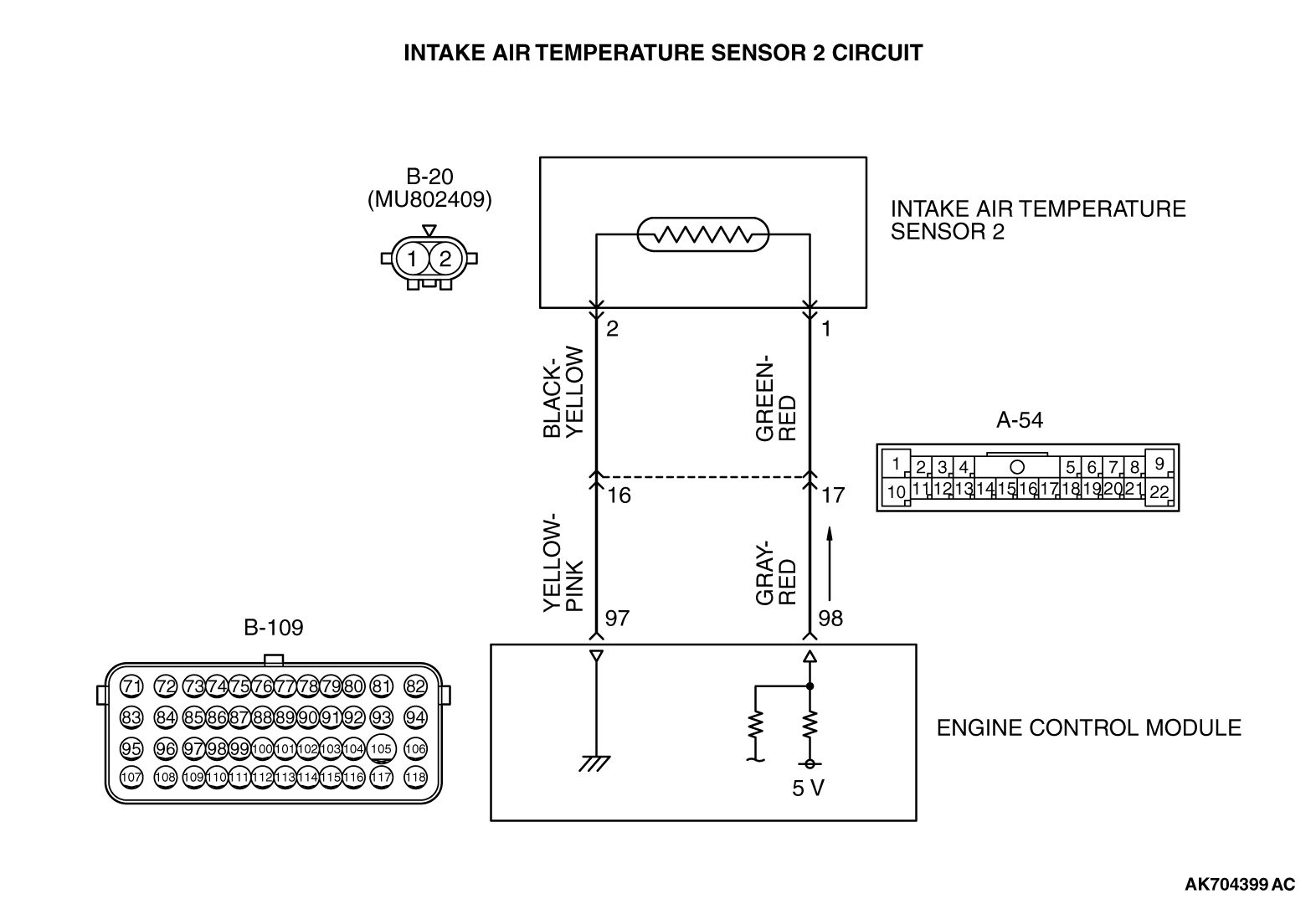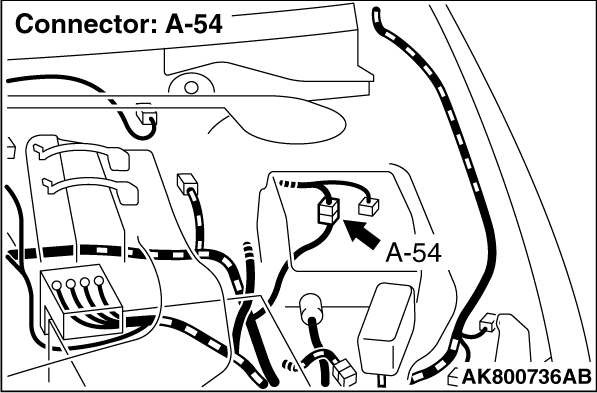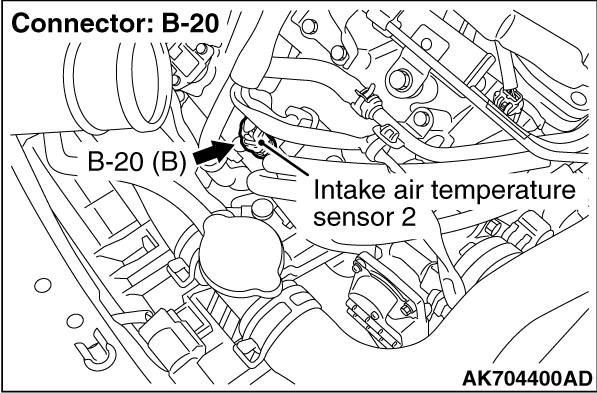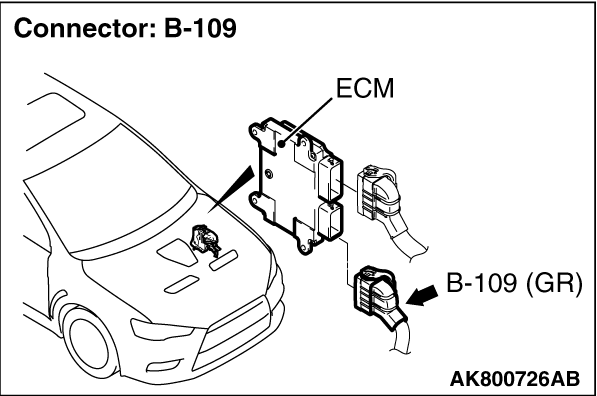![[Previous]](../../../buttons/fprev.png)
![[Next]](../../../buttons/fnext.png)
DTC P0097: Intake
Air Temperature Circuit Low Input (sensor 2)




CIRCUIT OPERATION
- Approximately 5 volts are applied to the intake air temperature
sensor 2 output terminal (terminal No. 1) from the ECM (terminal No. 98) via the resistor in
the ECM. The ground terminal (terminal No. 2) is grounded with ECM (terminal No. 97).
- The intake air temperature sensor 2 is a negative temperature coefficient type of
resistor. When the intake air temperature rises, the resistance decreases.
- The intake air temperature sensor 2 output voltage increases when the resistance
increases and decreases when the resistance decreases.
TECHNICAL DESCRIPTION
- The intake air temperature sensor 2 converts the intake
air temperature to a voltage.
- The ECM checks whether this voltage is within a specified range.
DESCRIPTIONS OF MONITOR METHODS
Intake air temperature sensor 2 output voltage is
out of specified range.
MONITOR EXECUTION
MONITOR EXECUTION CONDITIONS (Other monitor and Sensor)
Other Monitor (There is no temporary DTC stored in memory
for the item monitored below)
Sensor (The sensor below is determined to be normal)
DTC SET CONDITIONS
Logic Flow Chart

Check Condition
- More than 2 seconds have passed since the engine starting sequence was completed.
Judgement Criterion
- Intake air temperature sensor 2 output voltage is less than 0.2 volt [corresponding
to an intake air temperature of 115°C (239°F) or more] for 2 seconds.
FAIL-SAFE AND BACKUP FUNCTION
- Control as if the intake air temperature in the intake
manifold is 25 °C (77°F).
OBD-II DRIVE CYCLE PATTERN
Refer to Diagnostic Function - OBD-II Drive Cycle - Pattern
23  .
.
TROUBLESHOOTING HINTS (The most likely causes for this code to be set are:)
- Intake air temperature sensor 2 failed.
- Shorted intake air temperature sensor 2 circuit, or connector damage.
- ECM failed.
|
|
STEP 1. Check harness connector B-20 at intake air temperature
sensor 2 for damage.
|
|
|
Q.
Is the harness connector in good condition?
|
|
|
 Go to Step 2. Go to Step 2.
|
|
|
|
|
|
 Repair or replace it. Refer to GROUP 00E, Harness Connector Inspection Repair or replace it. Refer to GROUP 00E, Harness Connector Inspection  .
Then go to Step 5. .
Then go to Step 5.
|
|
|
|
|
|
STEP 2. Check the intake air temperature sensor 2.
|
|
|
(1)Disconnect the intake air temperature sensor 2 connector B-20.
|

|
(2)Measure the resistance between intake air temperature sensor 2 side connector terminal
No. 1 and No. 2.
- There should be continuity. (0.23 - 18 kΩ)
Q.
Is the measured resistance between 0.23 and 18 kΩ?
 Go to Step 3. Go to Step 3.
 Replace the intake air temperature sensor 2. Then go to Step 5.. Replace the intake air temperature sensor 2. Then go to Step 5..
|
|
|
STEP 3. Check harness connector B-109 at ECM for damage.
|
|
|
Q.
Is the harness connector in good condition?
|
|
|
 Go to Step 4. Go to Step 4.
|
|
|
|
|
|
 Repair or replace it. Refer to GROUP 00E, Harness Connector Inspection Repair or replace it. Refer to GROUP 00E, Harness Connector Inspection  .
Then go to Step 5. .
Then go to Step 5.
|
|
|
|
|
|
STEP 4. Check for short circuit to ground between intake air temperature
sensor 2 connector B-20 (terminal No. 1) and ECM connector B-109 (terminal No. 98).
|
|
|
| note |
Check harness after checking intermediate connector A-54. If intermediate connector is
damaged, repair or replace it. Refer to GROUP 00E, Harness Connector Inspection  . Then
go to Step 5. . Then
go to Step 5.
|
|
|
|
Q.
Is the harness wire in good condition?
|
|
|
 Replace the ECM. When the ECM is replaced, register the ID code. Refer to GROUP
42B, Diagnosis - ID Code Registration Necessity Judgment Table <Vehicles with KOS> Replace the ECM. When the ECM is replaced, register the ID code. Refer to GROUP
42B, Diagnosis - ID Code Registration Necessity Judgment Table <Vehicles with KOS>  or
GROUP 42C, Diagnosis - ID Codes Registration Judgment Table <Vehicles with WCM> or
GROUP 42C, Diagnosis - ID Codes Registration Judgment Table <Vehicles with WCM>  .
Then go to Step 5. .
Then go to Step 5.
|
|
|
|
|
|
 Repair it. Then go to Step 5. Repair it. Then go to Step 5.
|
|
|
|
|
|
STEP 5. Test the OBD-II drive cycle.
|
|
|
(1)Carry out a test drive with the drive cycle pattern. Refer to Diagnostic Function - OBD-II
Drive Cycle - Pattern 23  . .
|
|
|
(2)Check the diagnostic trouble code (DTC).
|
|
|
 Retry the troubleshooting. Retry the troubleshooting.
|
|
|
|
|
|
 The inspection is complete. The inspection is complete.
|
|
|
|
 .
.![[Previous]](../../../buttons/fprev.png)
![[Next]](../../../buttons/fnext.png)





 .
. Go to Step 2.
Go to Step 2. Repair or replace it. Refer to GROUP 00E, Harness Connector Inspection
Repair or replace it. Refer to GROUP 00E, Harness Connector Inspection  .
Then go to Step 5.
.
Then go to Step 5. Go to Step 4.
Go to Step 4. Repair or replace it. Refer to GROUP 00E, Harness Connector Inspection
Repair or replace it. Refer to GROUP 00E, Harness Connector Inspection  .
Then go to Step 5.
.
Then go to Step 5. Repair it. Then go to Step 5.
Repair it. Then go to Step 5. .
. Retry the troubleshooting.
Retry the troubleshooting. The inspection is complete.
The inspection is complete.